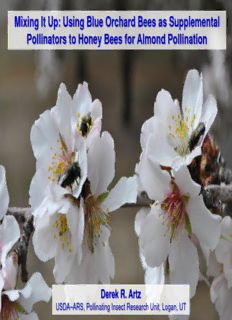
Mixing It Up: Using Blue Orchard Bees as Supplemental Pollinators to Honey Bees for Almond ... PDF
Preview Mixing It Up: Using Blue Orchard Bees as Supplemental Pollinators to Honey Bees for Almond ...
Mixing It Up: Using Blue Orchard Bees as Supplemental Pollinators to Honey Bees for Almond Pollination Derek R. Artz USDA–ARS, Pollinating Insect Research Unit, Logan, UT Global food supply and pollinators • Bees are the predominant and most economically important group of pollinators. • Honey bees are the primary agricultural pollinators for many worldwide crops. • Out of some 100 crop species which provide 90% of food worldwide, 71 of these are bee pollinated. United Nations Environment Programme Almonds • California’s top agricultural export • Largest tree nut crop in total value & acreage • 30 different varieties of almonds • 30% sold in U.S., 70% shipped internationally • Largest U.S. specialty crop export Almond Board of California Almond Orchards in CA (860,000 acres or 1,344 square miles) Area of Rhode Island is 1,214 sq miles Almond Pollination in CA Central Valley • Almonds are grown throughout CA’s Central Valley • Bloom occurs in mid-February • World’s largest pollination event • Our studies in southern Central Valley Lost Hills, CA at Paramount Farming Co. Lost Hills Almond Lifecycle & Harvest In early to mid-February, almond trees begin to bloom en masse. Almond Lifecycle & Harvest In early to mid-March, blossoms fall and pollinated flowers begin to develop fruits. Almond Lifecycle & Harvest Many almond trees are not self-pollinating so honey bees are brought in. Almond Lifecycle From March to June, almonds continue to mature, with the kernel forming. Almond Lifecycle & Harvest In July and August, hulls split open exposing the shell and allowing it to dry.
Description: